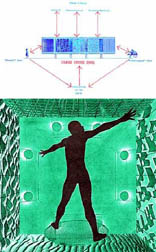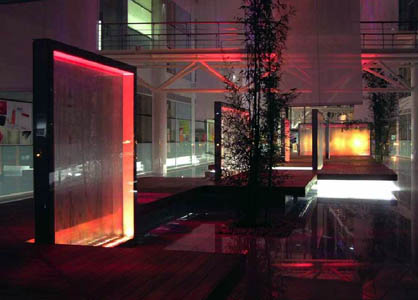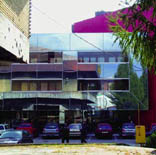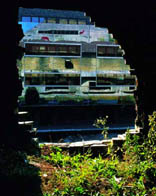[in
italiano]
> IT REVOLUTION BOOK SERIES
|
|
The work of Penezic & Rogina has marked important stages over the past twenty years. As thirty-year-olds, they established themselves at the Shinkenchiku competition, possibly the most important instance of international search for new architecture. In 1984 they won the first prize with a project based on -we were at the very beginnings- a re-interpretation of the layer concept used in the Diocletian's Palace. In a cultural climate permeated by historicism, and with Aldo Rossi among the judges, the two Croatian architects demonstrated that history need not necessarily mean historicism, that it could be reflected on the contemporary times and combined with the past by way of a logic that is not academic, and above all, by using new means.

An Architecture which is Kind to the Earth, Central Glass competition, 1999 (honourable mention 1999. Judges: Kisho Kurokawa, Kiyoshi Sakurai, Tetsuo Naito, Yoshiaki Ogura, Toyo Ito, Kazuhiro Ishii, Riken Yamamoto, Tomoyuki Inokuchi, Shozo Baba).
In the following years they presented interesting work, such as the compound of bathing facilities on the Sava river and they lived through the War in Croatia. Some projects on redecorations and interior design reflected such themes, for example, The Wall which asserts a new, digital sensibility, being at the same time a reinterpretation of the conflicts of the early nineties of the 20th century. Successively, they have established themselves through honorable mentions, awards and significant works in Croatia. In the year 2000 they achieved one of the most significant arrangements at the Biennale di Venezia. It is well known that this Biennale, under the slogan Less Aesthetics More Ethics, constituted a fundamental initiative towards the field of digital sensibility.
On this occasion Penezic & Rogina created a series of interconnected ambients which put the visitor into contact with architecture by way of changeable levels of perception, ranging from traditional ones to those characteristic of the new sensory and tactile research. Soon after, they finished The Dry Garden in Zagreb: a space for relaxation and gathering inside a pharmaceutical research building. The garden spans the digital sensibility with a treatment of space with transparent screens which contain water and light that is interactively modified. The presence of plant elements and furniture recalls a culture of oriental provenance.
Their masterpiece is the Block 21° edifice, done in Vukovar. In the demanding program of residential public construction, Penezic & Rogina have designed a work of immense concentration and harrowing presence. They reveal that it is possible to face the crises in architecture (in this case, the famous "also" can be achieved by showing numerous victims and an enormous destruction that Vukovar suffered during the 1991-1995 war).
|
|
[January 13, 2008] |


Glas House 2001, Central Glass competition, 1990 (2nd prize. Judges: Kisaburo Ito, Takekuni Ikeda, Shoji Hayashi, Kisho Kurokawa, Takefumi Aida, Kazuhiro Ishii, Masaki Umemoto).
|
|

Interior design for the Atrium of the Pliva Pharmaceutical Research Centre in Zagreb, 2001-2002.
Today they are in a happy phase. They have just finished a beautiful nursery school in Zagreb; they have been winning competitions, and they have many edifices in the works, some of which are published here. Now, we come to this book and its conception which is connected to a very particular occasion and a very particular place. A dozen of professional course participants, Penezic & Rogina, Nigel Whiteley and myself, spent a week with Cedric Price in an Istrian village of Grožnjan. This was in August of 2005. Those familiar with dates and events will notice that Cedric Price (1934- 2003) had already passed away two years before. But in reality, Price was not dead at all, he was actually there with us in all the things we were doing and saying: in the memories of his genius and his humour, in the stories of the places he had visited and of the things he had said in every nook of Grižnjan, where he held a seminar with our architects 15 years ago.
The intellectual and personal rapport between Penezic & Rogina and Cedric Price was very intense. It is a well known fact that Price was an architect sui generis. In the Sixties, he was already working at an idea of the decline of architecture as it was commonly understood. He demanded supremacy of technology, not in the spectacular dimension of high tech, but rather in that of the social advancement, of liberation and of creative solutions to difficult cases. He strongly influenced the thought of many architects, among them Penezic & Rogina who, having met him at the end of the eighties, have always turned to him as to a grand maestro and a friend. Nigel Whiteley is a professor of theory and architectural history and a scholar of both the international and British architectural scene, spurned on by the new phenomena of mass society. He authored some well-known volumes on pop and architecture and was a natural mediator between the experiences with Price and the new digital field that has been opening up. I myself was at Grožnjan because Vinko and Krešimir were friends of the IT Revolution in Architecture book series; they have been appreciative of it since its conception, they have promoted and reviewed it in Croatia; they have always emphasised the positive effect that the themes, tackled in the book series, have exercised on the development of the new generations of architects.
At the end of that week, after the seminar had finished, I remained a Grižnjan to carefully reread a trilogy of books dedicated to their work (edited by Cip Zagreb) and the essay Nigel himself had written for it. And I realized that the book you hold in your hands "absolutely" had to be published. To understand why I say "absolutely", the difference of the points of view between Whiteley and myself has to be explained. This book series is based on a Kuhnian idea on the affirmation of diverse scientific revolutions and on the change in the paradigm that they impose. I am convinced that we are in a historic phase, a phase of Information, which demands the formulation of an idea of architecture that is completely different than the one based on the industrial and mechanical paradigm of Functionalism. The name itself -information "revolution"- recalls this conviction. The text begins from a point of view that is not much different. Following certain ideas of Reyner Banham (on which he wrote a seminal book), Nigel believes in the idea of change, but based on "continuity" rather than on leaps. In fact, he names the various technological phases the first, second, third and fourth "age of the machine". There is, therefore, a quite sensible distinction here between reflection on the necessity of the change of paradigm and this, his way of thinking. It is no accident that one is based on a series of opposing pairs (new objectivity/new subjectivity is the more known) while that of Nigel has the formula of "and/and" at its centre.
This premise is necessary to explain how Nigel's approach might be particularly useful in tackling the specific case of Penezic & Rogina and in illuminating their work. In fact, while it is true that cultural commitment can (and in my opinion must) indicate with clarity the imposition of the change of paradigm, it is also true that in the reality of working on projects, especially in the reality of the one doing the construction, things are not so imperative. The various aspects of reality are combined not with oppositions, but frequently with insertions, superimpositions, and nuances. It is from these insertions and intersections that the changing, evolving, open architecture derives its power, not always in leaps, but also via continuous research and continuous examination.
This is why Nigel's text is truly illuminating, as is the key provided at the end, together with Kengo Kuma, when it is noted that the Croatian architects position reality by means of a process of digitalization that enables incorporation of elements in an always new working hypotheses. In the course of the entire book, Nigel Whiteley explains how different realities, encountered by the Croatian architects (the reality of the world in "Pop and Change", the reality of relations between "Modernism and Continuity" and the vanguards of the 20th century, the reality that regards "Beyond Time and Traditional Space" and the reality which launches itself into "Real Space and Time") are combined in the process of the transformation into (making itself concrete to) architecture.
Within this context, Penezic & Rogina can be seen as a part of that group of experimental architects of IT Revolution in Architecture (such as Kas Oosterhuis, Makoto Sei Watanabe, Gianni Ranaulo o Patrik Schumacher who have already published in the book series), on the other hand, they can be considered as one of the international architecture studies that are bringing about, with intense concreteness, force and interest, the new research on the Information Technology in the construction of reality.
Antonino Saggio
|
|



Social housing for war victims in Vukovar, Blocco 21A, 1998-2002.
|






